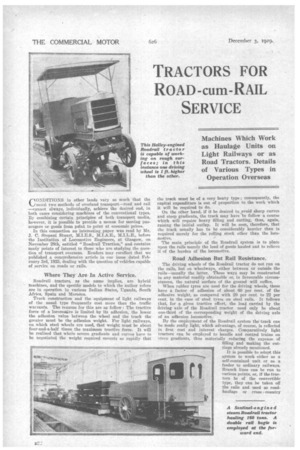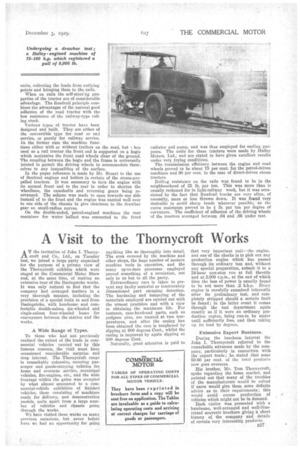TRACTORS FOR ROAD-cum-RAIL SERVICE
Page 52

Page 53

If you've noticed an error in this article please click here to report it so we can fix it.
riONDITIONS in other lands vary so much that the vl.J usual two methods of overland transport—road and rail —cannot always, individually, achieve the desired end, in both eases considering machines of the conventional types. By combining certain principles of both transport media, however, it is possible to provide a means for moving passengers or goods from point to point at economic prices.
In this connection an interesting paper was read by Mr. J. C. Stonani Stuart, M.I.E.S., M.I.A.E., M.I.L.E„ before the Institution of Locomotive Engineers, at Glasgow, on November 28th, entitled " Roadrail Traction,"and contains matiy points of interest to those who are studying the,question of transport overseas. Readers may recollect that we published a comprehensive article in our issue dated February3rd, 1925, dealing with the question of vehicles capable of service on roads or rails.
Where They Are In Active Service.
Roadrail tractors, as the name implies, . are hybrid machines, and the specific models to which the author refers are in operation in various Indian States, Uganda, South Africa, Spain and Morocco.
Track construction and the equipment of light railways of the usual type frequently cost more than the traffic warrants. The reasons for this are as follow: The tractive force of a locomotive is limited by its adhesion, the lower the adhesion value between the wheel and the track the greater must be the adhesion weight. For light railways, on which steel wheels are used, that weight must be about four-and-a-half times the maximum tractive force. It will he realised that wheie severe gradients and curves have to be negotiated the weight required mounts so rapidly that the track must be of a very heavy type; consequently, the capital expenditure is out of proportion to the work which it will be required to do.
On the other hand, if it be desired to ,avoid sharp curves and steep gradients, the track may have to follow a course which will require heavy filling and cutting, thus, again, raising the initial outlay. It will be seen' therefore, that the track usually has to be considerably heavier than is required merely for the rolling stock other than the locomotive.
The main principle of the Roadrail system is to pingo upon the rails merely the load of goods hauled and to relieve it of the burden of the locomotive.
Road Adhesion But Rail Resistance.
The driving wheels of the Roadrail tractor do not run on the rails, but On wheelways, either between or outside the rails--usually the latter. These ways may be constructed in any material readily obtainable or, in favourable circumstances, the natural surface of the ground will suffice.
When rubber tyres are used for the driving wheels, these have a factor of adhesion of about 60 per cent. of the adhesive weight, as compared with 20 per cent to 22 per cent, in the case of steel tyres on steel rails. It follows that, for a given tractive effort, the load carried by the driving axle of the Roadrail tractor need only be about one-third of the corresponding weight of the driving axle of an adhesion locomotive.
By the employment of the Roadrail system the track can be made really light, which advantage, of course, is reflected in first cost and interest charges. Comparatively light tractors can be employed to handle and control trains on steep gradients, thus materially reducing the expense of units, collecting the loads from outlying points and bringing them to the rails.
When on rails the self-steer:ng properties of the tractor are of considerable advantage. The Roadrail principle combines the advantages of the natural good adhesion of the road tractor with the low resistance of the railway-type rolling stock.
Various types of tractor have been designed and built. They are either of the convertible type for road or rail service, or purely for railway service. In the former case the machine functions either with or without trailers on the road, but hen used as a rail tractor the front end is supported on a bogie which maintains the front road wheels clear of the ground. The coupling between the bogie and the frame is universally jointed to permit the driving wheels to accommodate themselves to any inequalities of the surface.
In the paper reference is made by Mr. Stuart to the use of Sentinel engines and boilers in certain of the steam-propelled tractors. It was necessary to turn the engine with its normal front end to the rear in order to shorten the wheelbase, the camshafts and reversing gears being rearranged. The ashpan was made to open towards one side instead of to the front and the engine was carried well over to one side of the chassis to give clearance to the drawbar gear on small-radius curves.
On the double-ended, petrol-engined machines the rear container for water ballast was connected to the front tadiator and pump, and was thus employed for cooling purposes. The units for these tractors were made by Halley Motors, Ltd.; and are stated to have given excellent results under very trying conditions.
The transmission efficiency between the engine and road wheels proved to be about 75 per, cent, for the petrol-driven machines and 90 per cent, in the case of direct-driven steam tractors.
Rolling resistance on the rails was found to be in the neighbourhood of 25 lb. per ton. This was more than is usually reckoned for in light-railway work, but it was occasioned by the fact that Roadrail tracks are very often, of necessity, more or less thrown down. It was foand very desirable to avoid sharp bends wherever possible, as the curve resistance proved to be lb. per ton per degree of curvature. The coefficient of adhesion of the driving wheels of the tractors averaged between .04 and .66 under test.




















































































































